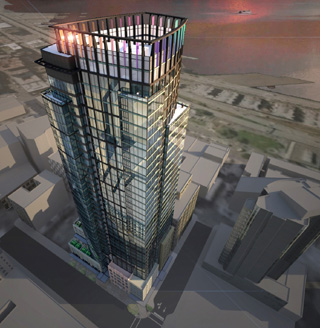
Surveys
DJC.COM
December 11, 2008
Market District evolves as a walkable neighborhood
Weber Thompson

Weber
|
The downtown urban centers of many West Coast cities are witnessing a renaissance. With investment from developers and business owners, city centers have become much more vibrant, attracting suburban residents seeking a more engaged, pedestrian-focused lifestyle.
The resurgence in city living is particularly apparent in Seattle, where government and business leaders understand how essential residential development is to a city’s lifeblood. Through innovative policies, these leaders are providing vital support and infrastructure to encourage urban development and create a 24/7 community that lives, works and plays.
The West Coast is home to a number of extraordinarily walkable neighborhoods, from the Lamplight District in San Diego to the Pearl District in Portland. And though Seattle may be a bit late to the party, we also have a number of emerging pedestrian-friendly downtown neighborhoods, including Belltown and the rapidly evolving South Lake Union area. Another burgeoning neighborhood is the Market District, which will soon welcome several thousand new residents, hotel guests and high-quality retailers that will revitalize the area around the Pike Place Market, the heart of Seattle.

Image courtesy of Weber Thompson Nineteen Twenty-One Second Avenue will have 190 residences, 154 hotel rooms and nearly 6,500 square feet of retail. |
The neighborhood has “a history as rich and colorful as the produce” sold at the market, according to the American Planning Association, which last year named the area to its Ten Great Neighborhoods in America list. The group called the community “Seattle’s most compact, walkable and diverse neighborhood.”
Home to more than 200 businesses, as well as sales stalls for 120 farmers and 190 craftspeople, it’s no wonder the market itself attracts more than 10 million visitors each year.
An eclectic mix of uses is a key component of any great neighborhood. In addition to the famous market, the Market District is home to a rapidly expanding mix of upscale condominiums and apartments, affordable-income housing, a health clinic, a food bank, a senior center and childcare center.
Add to this the significant transportation investments, including Sound Transit’s new rapid express bus and light-rail service, which makes accessing the area that much easier, and you have all of the walkable neighborhood qualities that one could ask for.
“The neighborhood shows just how convenient and interesting urban living is,” American Planning Association’s Executive Director Paul Farmer said.
New projects, new energy
Not surprisingly, developers are attracted to what is rapidly becoming one of Seattle’s most exciting, self-contained pedestrian neighborhoods. Seven mixed-use residential and hotel projects are under construction or seeking permits in the Market District. This rapid increase in both the residential population and the number of visitors is also attracting the attention of upscale retailers, restaurateurs and art gallery owners.
Recently the area added a full-service grocery store, the IGA Kress Supermarket at Third and Pike. Coming soon is a Columbia Sportswear store on Third and Pine and a Hard Rock Café at Second and Pike.
To an area that already sees up to 20,000 pedestrians on a busy day, all of these projects will attract even more shoppers and walkers — and bring new energy to the neighborhood.
Is this trend for real?
With housing and capital markets in turmoil, it’s fair to ask if this migration to our urban centers will continue. Experts agree that, despite the national economic slowdown, we are witnessing significant consumer behavior patterns and psychographic shifts toward more socially engaged lifestyle choices. People are looking for new ways to live, and for many the city is where they want to be.
The demand for dense, walkable neighborhoods will only increase in the next decade, according to John McIlwain, senior fellow at the Urban Land Institute. “Cities are where the action is now, and this trend is likely to continue for the foreseeable future. Boomers are aging and empty-nesters think of cities as a good place to retire, as well as the place to continue to work.”
In general, urban properties in 24-hour, global-pathway cities are holding up better than those in suburbs and secondary markets, according to the Urban Land Institute’s 2009 Emerging Trends report. And among these cities, Seattle’s real estate market is the best, the report states.
“Seattle is one of our country’s global-pathway markets and really has achieved 24-hour status,” said Jonathan Miller, a PricewaterhouseCoopers consultant and lead author of the Emerging Trends report.
Further fortifying the trend is the generation of younger buyers programmed on sitcoms such as “Seinfeld,” “Friends” and “Sex in the City.” They don’t need to be sold on the idea of downtown living.
Local economist Matthew Gardner predicts that the number of creative-class jobs in the Puget Sound region will continue to grow. He estimates that, current slowdown aside, the fundamentals are in place for continued in-migration of high-tech, knowledge-based workers. These are the future buyers who will keep this trend in play for many years.
There are practical reasons, as well as the “coolness” factor, driving the trend.
| Several projects coming to the Market District |
|
In addition to the recently opened Fifteen Twenty-One Second Avenue and the Four Seasons Seattle projects, other developments will transform Seattle’s Market District: • Among the newest to be announced is Touchstone Development’s 12-story hotel/apartment project at 1900 First Ave. Designed by Olson Sundberg Kundig Allen, it is distinguished visually through the texture and pattern of surface treatments and unique window fenestration. Plans call for 75 apartments and 100 hotel rooms. • The Candela Hotel, another Olson Sundberg Kundig Allen-designed project, is a 35-story mixed-use project at the southeast corner of Second and Pike. It is being developed by Urban Visions in collaboration with Tom Pigott, founder of Candela Hotels. The project includes 130 hotel rooms, 98 condominiums and 7,000 square feet of retail. • Columbia West, in collaboration with The Justen Co., is developing two projects at Second and Virginia. Together, the 38-story towers will create a gateway to the Market District. Nineteen Twenty-One Second Avenue is a mixed-use project with 190 residences, 154 hotel rooms and nearly 6,500 square feet of retail. Twenty Twenty-One Second Avenue will have 234 residential units and nearly 7,800 square feet of retail. Weber Thompson is designing both. |
Suburbanites for decades have dealt with long commutes in search of the American dream. But as suburbs become more congested, gas prices fluctuate and personal time becomes precious, many are seeking a less auto-centric lifestyle.
Northwest economist Joe Cortright says that because people want to spend less money on energy, housing prices in urban, walkable neighborhoods will hold up better than home prices in the suburbs.
There’s also the desire to downsize and simplify life, and a psychographic shift toward “hiving,” or reconnecting with others in what are known as third places, such as sidewalks and parks, coffee shops, bars, restaurants, entertainment venues and in the common areas of multifamily dwellings. These places facilitate connection and community, and they are at the heart of healthy neighborhoods.
For some, living in the city is about not having to cut the grass or paint the house any more. It’s about a more carefree, lock-and-leave lifestyle. Don’t feel like cooking tonight? There are 100 restaurants in downtown Seattle. Movies, plays, concerts, professional sports, art galleries and clubs are nearby and easy to get to.
Last but not least, scientists who study urban health have long argued that walking has extraordinary health benefits. The very nature of a city coerces us to exercise far more than people who live elsewhere in a way that is strongly correlated with longer life expectancy.
Downtown is where the action is, both socially and professionally. No neighborhood offers this kind of lifestyle better than the Market District.
The injection of so many new homeowners, apartment dwellers, hotel guests and workers into the Market District in a very short period of time will not only support existing businesses and the market itself, it will foster positive changes.
With more eyes on the street, the sidewalks will become safer. Improvements such as modern, open storefronts, new sidewalk paving, landscaping and street furniture will foster a rich pedestrian experience. The area already buzzes with new energy, proving that density can transform a city neighborhood into a wonderful place to live, work, shop and play.
While the current economic slowdown may affect the pace of change in our downtown cores, the trend has too many drivers to be stopped. Anyone who fails to appreciate the power of this back-to-the-city movement — which is transforming how we live, how we think, how we interact — will miss the opportunity of our lifetime.
Blaine Weber, AIA, is an architect and founding principal of Seattle-based Weber Thompson, a highly diversified design agency. He is the senior principal leading the firm’s Urban Projects/Highrise Team.
Other Stories:
- CBA speakers take on the economy
- A green future for savvy developers
- Making green design deliver ROI, not just LEED
- Mixed-use projects can pay off handsomely
- Local retailers will fare better than others
- Suburban hubs will draw tomorrow’s renters
- Seattle’s office market: No more high-fiving
- Industrial market hums along, but don’t hold your breath
- CBA ready to mint a new breed of green brokers
- Weathering the storm
- Young guns take their shot at the market
- David A. Sabey
Sabey Corp. - Sean G. Hyatt
Trammell Crow Residential - Lynn Michaelis
Weyerhaeuser Co. - Dan Ivanoff
Schnitzer West - Commercial real estate prepares for the future
- The pitfalls of renting out condo projects
Copyright ©2009 Seattle Daily Journal and DJC.COM.
Comments? Questions? Contact us.